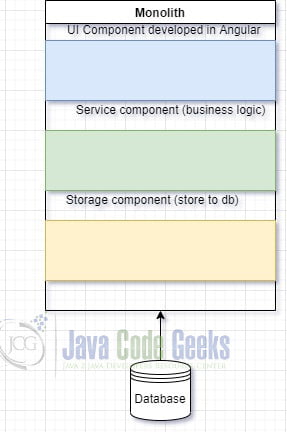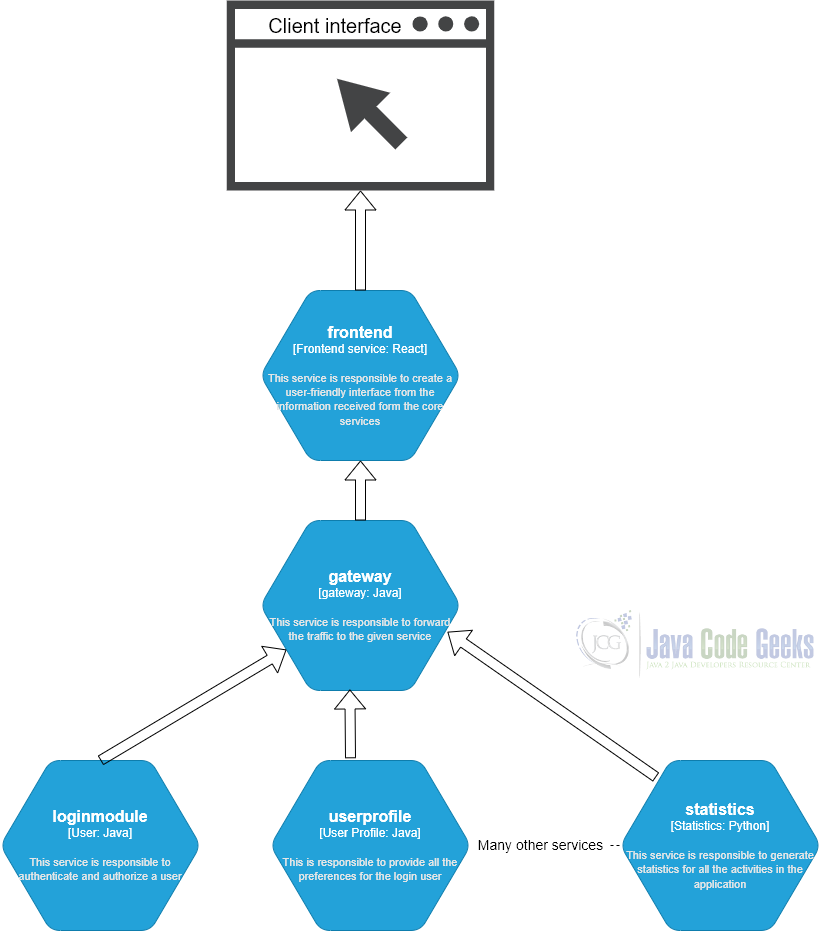Monolithic vs Microservice Architecture
In this article we will show you the monolithic vs microservice architecture.
1. Introduction
In this article, we will cover some of the most important architecture that most of the developers use when developing web or service applications.
The term monolithic stands for the word that is a single service, homogeneous and unitary, unable to be used modularly. This is a single-unit application type.
The term microservice stands for Service Oriented Architecture, another concept that we will discuss in detail in the next sections. This refers to the idea of having small services which are loosely coupled.
2. Monolithic architecture
Monolithic is a single unit application. Usually the application is packaged into a war or ear file. These are the traditional ways of application that have no limited module boundaries. However the best term to describe the monolithic architecture is an application that can grow over time. As a result of this approach it will be conducted to an unmanageable and difficult to understand over time once the project gets bigger.
2.1 Advantage of monolithic architecture
- simple to build at the beginning (but as the application evolves it is hard to maintain).
- easy to test and debug. Since this is a single app unit running the entire business logic, meaning that you can run an end to end test.
- all components sharing the same memory means a significant performance than service to service communication.
- all frameworks, templates or scripts are located in the same location.
- since it’s a single unit, certainly is easy to deploy the application
2.2 Disadvantage of monolithic architecture
- As the complexity of an application grows a new team member takes a bit longer to understand the entire monolith application.
- In case the maturity of the application increases, fixing some small part from the application, needs a downtime for the entire application.
- Since the application is a single unit it is hard to scale and optimize the resource from a host. If you want to increase the memory and CPU for some part of the application you will have to increase it for the entire application even if some components are not needed.
- Due to this fact you will not be able to integrate with a new framework.
- It will not be possible to have different types of languages.
More information about monolithic applications can be found here. Likewise for advantages and disadvantages you can find relevant information here.

3. Microservices architecture
Microservice applications promote the idea of cloud infrastructure. This type of architecture is very similar to the Service Oriented Architecture(SOA). SOA is an architectural style that supports service orientation. As microservice architecture prompts the concept of loose coupling between services. However the SOA means too many different things because the focus is on the Enterprise Service Buses (EBS).
Each microservice exposes an API that will allow you to communicate between services. The microservices will be discoverable by each other through a service manager like Hazelcast. When a new service will start-up, that service will be registered in Hazelcast and when a new service wants to call a service, Hazelcast will facilitate this.
This architecture tries to solve some problems of the monolithic architecture like the complexity of the application due to the fact that it will split the code into independent modules. Each service encapsulates business capabilities.
3.1 Advantages of microservice
- be able to use different languages for each service
- small service and easy to understand
- scaling horizontally
- easy to deploy
- independent management
- in case one on the service failed to server requests the rest of the application can be use further
- each microservice can have their own database
3.2 Disadvantage of microservice
- the communication between services is a bit complex
- as the number of the services increase the resources will also increase
- a difficult way to test globally as a whole
- some deploy for multiple microservices will not be straightforward, because needs some coordination between services
More information about microservice applications you can find out here.

4. Monolithic vs microservice architecture
To clarify better with the most notable information about both types of architecture below are the differences.
| Monolithic | Microservice |
| Is a single unit application
Scaling vertically One single programming language Easy to deploy on a single host Unable to server the clients in case the application have some errors |
Multiple small applications with their own business function
Can be scaled horizontally Multiple microservices can have multiple programming languages In case the one of the non-core server will fail the rest of the application will be able to be used |
5. Which software architecture suits your business solution?
The monolithic architecture best suits small applications, growing enterprise applications can not. The monolithic architecture best suits small applications, growing enterprise applications can not afford to have downtime to update the whole application for a small change in a certain type of business logic. Type of example for monolithic application: small e-commerce with limited functionality to order.
On the other hand, microservice applications are suitable for large applications having different services, and each service has its own role, having a given business function (e.g: payment, login, user profile, and others). Also suitable in case you want to distribute different services on different hosts. It will be able to allocate the resources to a certain host as it needs. For example applications like online streaming, applications that collect multiple data and process them. This type of architecture is great for larger companies that handle thousands of requests every second some days.
6. Summary
In conclusion, we explore both concepts of architecture. For each concept, we described how a monolithic application looks in contrast with the microservice architecture. Besides that we also look at some benefits that each architecture model has and where is the best place to use each of them.
To sum up, this article will help you to get a better understanding of this type of architecture. As a result, after this article, you will be able to decide which one suits you best.



